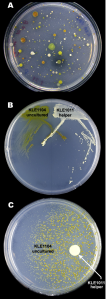Despite the fact that I really don’t celebrate VD (Valentine’s Day, in case you were thinking something else), I thought I would show a little love, share a warm-fuzzy, and re-post this from Suzanne Kennedy (clearly, a woman after my own heart) at the MoBio Blog, The Culture Dish.
Oh how do I love thee? Let me count the ways…
Show some LOVE for Environmental Microbiology
Do you love your work? Does nothing make you happier than a day out in the field collecting soil from the rainforest floor, in a boat collecting Vibrio contaminated water from Puget Sound, traipsing the forest looking for animal droppings from wild birds in Venezuela, or aboard the Alvin collecting biofilms from deep sea floor hydrothermal vents?
It’s important to love your work and fortunately for us, there is so much to love about microbiology and the environment. But to find out what is best about working in this field, I asked the question to several of my scientist friends: What do you love about your work? Why do you study environmental microbiology and what is it that makes it the best field of work?
And below are some of the best responses. Some are my own, but most are responses I received from people who study some of the most unusual samples from the most extreme environments in the world. I think you will agree that environmental microbiology provides experiences unlike any other field. Let us know your reasons for loving your work!
14 Reasons to Love Environmental Microbiology:
1. You get to play outside in the mud, snow, water or clouds (see picture at end of article).
2. There is virtually an unlimited number of research projects to choose from. “Microbiologist William B. Whitman, estimates the number of bacteria in the world to be five million trillion trillion. That’s a five with 30 zeroes after it. Look at it this way. If each bacterium were a penny, the stack would reach a trillion light years.”
3. Your research will have an impact on everything living on the planet, humans, animals, and plants. Basically all the Kingdoms benefit from what you do.
4. You have the opportunity to visit exotic and remote locations.
Graduate student Rick Davis explains,
“I think I’ve been really lucky with the places I get to study– I got to go to Samoa, Hawaii, and Yellowstone this year!”
He also added reason number 5:
5. Environmental microbiologists are more laid back and generally more collaborative than competitive, which allows for greater progress and more fun at conferences!
John Mackay, a molecular biologist and director of business development at the plant diagnostic company, Linnaeus, tells me:
6. You can cruise around the seas for months, sequence a bit of sea water and write the whole lot off on your research grant!
7. You can work on things you can eat or drink – I recommend wine and truffles!
8. When you find new species (almost a given!), you can name them after yourself.
New discoveries are also what motivates Charlie Lee from the University of Waikato, a Postdoctoral researcher in microbial ecology studying the Dry Valleys of Antarctica. He echoes the sentiment that discovery is almost a guarantee:
9. Most systems we look at are relatively poorly understood, and it’s always exciting to discover something for the first time.
Tom Niederberger, a Postdoctoral researcher in marine biosciences at the University of Delaware, has more to add:
10. The international travel is a great reward. The world is your playground as microbes have colonized basically all habitats on earth, and it’s great to travel around sampling not only the microbes, but new cultures/food/travel etc. and not being chained to the lab and pipette. Also the international collaborations and conferences also are great.
11. But I think what is most important is that microbes in the environment are essential not only for the health of the planet (e.g. global nutrient cycling / global climate change) but they are also intimately linked to the healthy functioning of our bodies. i.e. the are really important!
12. Also,there is the excitement of the unknown. Most of the organisms cannot be cultured and we know nothing about them…I think this is great motivation and it will keep you busy, and there are always new problems to solve and new questions to ask.
All excellent points!
And from a molecular biologist from Colorado State University (who wished to remain anonymous) come two excellent points I hadn’t considered:
13. Extremists don’t kidnap environmental microbiologists. Actually, they give them back.
14. If you get tenure, who’s going to boot you out? Exxon?
Did I mention that environmental microbiologists are funny?


